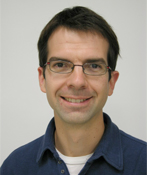_
_

_

Director of Graduate Studies in Rehabilitation Sciences and Associate Professor
Contact details (Research)
Center for Interdisciplinary Research in Rehabilitation of Greater Montreal (CRIR)
Institut universitaire sur la réadaptation en déficience physique de Montréal (IURDPM)
Pavillon Gingras-Lindsay de Montréal
6363, Chemin Hudson
Montréal (Québec) H3S 1M9
T 514 340-2085, poste 3048
Contact details (School of Rehabilitation)
T 514 343-6111, poste 26381
cyril.duclos@umontreal.ca
Program
Physiotherapy
Education
- French physical therapist diploma, Institut de Formation en masso-kinésithérapie d’Orléans, France (1998)
- B. Sc., Cognitive neurosciences, Université d’Aix-Marseille I, France (2000)
- M. Sc., Physiology and biomechanics, Université Paris-X, France (2002)
- Ph. D., Neurosciences, Université d’Aix-Marseille I, France, & Biomedical sciences, rehabilitation option, Université de Montréal (2006)
- Post-doctoral studies
- Pathokinesiology laboratory, CRIR, Montréal (2006-2009)
- Research centre, Montréal geriatric university Institute (2008-2009)
- Sobell Department, Institute of Neurology, University College, London (2009)
Current research projects
- Gait-like sensorimotor stimulations to improve gait function after SCI (Fondation Craig H Neilsen, USA).
- Reaching clinical recommendations for intensity of post-stroke rehabilitation using an activity circuit implemented with a change agent (FSI-SSS/MEDTEQ)
- Rehabilitation dog in post-stroke rehabilitation: a pilot study for a new intervention (OPPQ-REPAR)
- Unpredictable perturbations during gait to improve balance performance
- Osseointegration in individuals with lower-limb amputation
Selected publications
- Paquin, M.-H., Duclos, C., Lapierre, N., Dubreucq, L., Morin, M., Meunier, J., Rousseau, J., & Dumoulin, C. (accepté). The effects of a strong desire to void on gait for incontinent and continent older community-dwelling women at risk of falls. Neurourology and Urodynamics.
- Duclos, N. C., Aguiar, L. T., Aissaoui, R., Faria, C., Nadeau, S., & Duclos, C. (2019). Activity monitor placed at the nonparetic ankle is accurate in measuring step counts during community walking in poststroke individuals: a validation study. PM&R, 11(9), 963-971. doi:10.1002/pmrj.12080
- Duclos, N. C., Aguiar, L. T., Aissaoui, R., Nadeau, S., & Duclos, C. (2019). Pertinence et implications de l’actimétrie en réadaptation. EMC – Kinésithérapie-Médecine physique-Réadaptation, 15(3), 1-9. doi:10.1016/S1283-0887(19)65816-0
- Fortin, C., Pialasse, J. P., Knoth, I. S., Lippe, S., Duclos, C., & Simoneau, M. (2019). Cortical dynamics of sensorimotor information processing associated with balance control in adolescents with and without idiopathic scoliosis. Clinical Neurophysiology, 130(10), 1752-1761. doi:10.1016/j.clinph.2019.07.005
- Miéville, C., Lauzière, S., Betschart, M., Nadeau, S., & Duclos, C. (2018). More symmetrical gait after split-belt treadmill walking does not modify dynamic and postural balance in individuals post-stroke. Journal of Electromyography and Kinesiology, 41, 41-49. doi:10.1016/j.jelekin.2018.04.008
- Dubreucq, L., Mereu, A., Blanc, G., Filiatrault, J., & Duclos, C. (2017). Introducing a psychological postural threat alters gait and balance parameters among young participants but not among most older participants. Experimental Brain Research, 235(5), 1429-1438. doi:10.1007/s00221-017-4902-y
- Barthélémy, A., Gagnon, D. H., & Duclos, C. (2016). Gait-like vibration training improves gait abilities: a case report of a 62-year-old person with a chronic incomplete spinal cord injury. Spinal Cord Series And Cases, 2, 16012. doi:10.1038/scsandc.2016.12
- Ilmane, N., Croteau, S., & Duclos, C. (2015). Quantifying dynamic and postural balance difficulty during gait perturbations using stabilizing/destabilizing forces. Journal of Biomechanics, 48(3), 441-448. doi:10.1016/j.jbiomech.2014.12.027
Research interests
- Control and rehabilitation of balance during gait
- Simple and complex proprioceptive stimulations for rehabilitation
- Localized muscle vibration
- Motion analysis
- Inertial sensors
